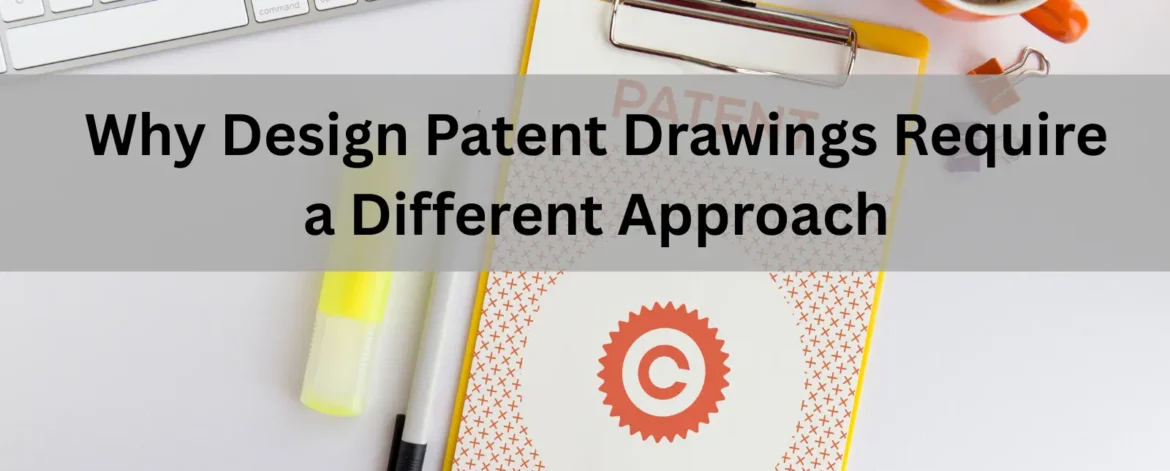In the world of intellectual property, drawings are more than illustrations — they are a visual declaration of rights. While both design and utility patents rely on technical drawings to communicate inventions, the expectations, styles, and rules governing Design Patent Drawings are notably different. These differences are not just procedural—they are foundational.
At The Patent Drawing Services, we specialize in providing compliant, high-precision drawings tailored to both utility and design patents. In this article, we’ll explore what makes Design Patent Drawing unique, why they demand a specialized approach, and how Patent Draftsmen must treat them with a distinct methodology involving line rules, shading, hatching, and surface definition.
Understanding Design vs. Utility Patent Drawings
To fully appreciate the specialized nature of Design Patent Drawings, one must first understand their legal context.
Utility patents protect how an invention functions. The drawings in these applications explain mechanisms, electrical logic, or structures relevant to functionality.
Design patents, on the other hand, protect the ornamental appearance of a product. These drawings are the sole definition of the claim. What is shown is protected — and what is not, is not.
Hence, while utility drawings support the written specification, design patent drawings are the specification.
The Legal Role of Design Patent Drawings
The U.S. Court of Appeals for the Federal Circuit has emphasized that the design patent claim is defined entirely by the drawings. This means that the entire enforceable scope of a design patent — what it covers and protects — lives within those visuals.
Unlike utility applications, there are typically no textual claims beyond a general statement: “The ornamental design for , as shown and described.” Thus, every line, curve, shadow, and hatch matters — and must be executed with the utmost care.
Why Precision in Design Drawings Is Critical
Imagine filing a design patent for a new bottle shape. If the drawing fails to clearly indicate the curvature of the neck or uses inconsistent line weights that confuse the boundary between body and cap, your protection may be invalidated or limited.
Design Patent Drawings must:
- Be consistent across views (front, rear, top, bottom, left, right, perspective)
- Use correct line types to differentiate claimed vs. unclaimed features
- Show complete surface texture or transparency if relevant
- Avoid overcomplication or omission that misrepresents the design
This is where skilled Patent Draftsmen become invaluable.
4. Key Elements That Set Design Patent Drawings Apart
A. Line Quality
Linework in design patent illustrations must follow strict conventions:
Solid lines indicate parts of the design that are being claimed
Broken (dashed) lines show unclaimed or environmental structure
Thin, uniform line thickness is required throughout — bold outlines are generally rejected
B. Shading and Surface Definition
Shading is essential to show contours, curvature, and surface characteristics. It helps distinguish between:
Flat vs. curved surfaces
Recessed vs. protruding features
Transparent vs. opaque parts
There are two main types:
- Stippling: A series of dots to represent shading — ideal for soft, curved surfaces
- Line shading: Parallel or radial lines used to show shape and depth
Important: Improper or inconsistent shading may render the drawing ambiguous — which the USPTO sees as grounds for objection.
Hatching
In utility patents, hatching is commonly used in sectional views to show material types or cut surfaces. In design patents, hatching has limited use but may appear in combined applications or where a sectional perspective clarifies complex geometry.
However, excessive use of hatching in design drawings is discouraged unless specifically requested.
Broken Lines
Broken lines are one of the most powerful tools in a design patent drawing. They help the applicant:
Define the boundary between claimed and unclaimed areas
Include enough context for the examiner to understand the object’s orientation
Avoid claiming parts that may change in future models
Example: If you are patenting the grip design of a toothbrush, you would show the bristle head and handle in broken lines while the grip area is in solid lines — making it clear that only the grip is claimed.
Consistency Across Views
The USPTO requires at least 7 standard views for most products:
Front
Rear
Left
Right
Top
Bottom
Perspective (Isometric)
These must be perfectly aligned in terms of scale, position, and proportion. Inconsistency can lead to rejections or even render the patent unenforceable.
Importance of USPTO and International Compliance
Each jurisdiction has its own formatting expectations, but most major patent offices — including the USPTO, EPO, and JPO — follow similar drawing standards.
USPTO-specific rules include:
Black-and-white line drawings unless color is claimed
No shading that obscures features
No text or branding visible in the design
Design applications that intend to go global (e.g., under the Hague Agreement) must adhere to WIPO standards, which may differ slightly in terms of line tolerance, margin size, and page formatting. A professional team ensures that a single set of drawings is compliant worldwide.
How Patent Draftsmen Approach Design Patents
At The Patent Drawing Services, our approach to Design Patent Drawing is methodical and precision-driven:
- Client Intake
We collect CAD files, product images, or sketches with dimension references. - View Planning
We determine the most effective way to showcase the design in all mandatory views. - Line Calibration
Our team applies strict control over stroke weight, line style, and spacing. - Surface Definition
Where necessary, we add stippling or line shading to express the form. - Cross-Review
Every drawing is reviewed by a patent professional to ensure USPTO and global compliance.
Our drafting team consists of specialists trained in design logic, IP law, and global standards, ensuring zero errors and zero office actions related to drawing quality.
Common Mistakes to Avoid in Design Patent Drawings
❌ Inconsistent views
Front view shows 7 ridges, top view shows 6 — automatic rejection.
❌ Unclear surface curvature
Flat shading misrepresents a domed surface.
❌ Improper use of broken lines
Including features in solid line that were not intended to be claimed.
❌ Missing views
Lack of a perspective view can make understanding the form difficult for examiners.
A qualified Patent Draftsman eliminates these risks from the outset.
Our Process at The Patent Drawing Services
We’ve helped startups, law firms, and enterprises across the globe obtain flawless, enforceable design patents. Our workflow includes:
Fast Turnaround – Most drawings delivered within 2–3 business days
Full USPTO + PCT Compliance
Revision Support – No additional charge for format tweaks
High-Resolution PDF + DOCX formats
Global Adaptability – Ready for WIPO, EPO, and JPO filing
From furniture and packaging to medical devices and consumer electronics, our Design Patent Drawing services bring form and function together on paper.
Final Thoughts
Design patents offer powerful protection for product aesthetics — but they rely entirely on the quality and accuracy of their drawings. Unlike utility patents, there’s no room for vague wording or post-filing adjustments. What you see is what you claim — and what you can defend.
Choosing a drawing team that understands the nuances of shading, broken lines, hatching, and view consistency isn’t optional — it’s essential.
At The Patent Drawing Services, we specialize in delivering industry-grade visuals that do more than meet standards — they strengthen your IP.
Contact our expert drafting team today at
🌐 thepatentdrawing.com
📧 info@thepatentdrawing.com
Let us show your design — the right way, the first time.





